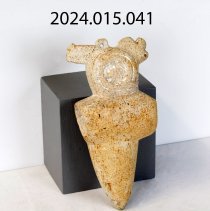Object Record
Images

Metadata
Catalog Number |
2024.015.041 |
Object Name |
Pestle |
Description |
This pestle carved in dense stone, or ceremonial mace head with stylized macaw, originates from the Arawak People of the West Indies. A mace is a blunt weapon, a type of club that uses strength on the end of a handle to deliver powerful strikes and bludgeon its target on impact. It typically consists of a strong, heavy, wooden or metal shaft, often reinforced with metal and has a head made of stone, bone, copper, bronze, iron, or steel. Mace heads like this one were made around 2500BC and were typically used for combat. Elaborate mace heads were also created as ceremonial objects and symbols of power within Stone Age tribes. The head of a mace can be shaped with flanges or knobs to increase the pressure of an impact by focusing the force on a small point. This effect increased the ability of the mace to injure an armored opponent through weak spots in the armor, and even damage plate armor by denting it, potentially binding overlapping plates and impeding the wearer's range of motion. Special thanks to Dr. Althia Ali for researching this vessel alongside Reece Museum staff. This research was made possible by the Luce Foundation. Upon arriving to the Reece Museum, detailed cleaning was needed due to the accretion of a white substance within the crevices of the artifact. When gently removing the accretion, the substance smelled strongly of paint. This leads to questions regarding how paint might have gotten onto this artifact, and whether this artifact is an authentic ceremonial piece. For now, it is being treated as such until evidence suggests otherwise. |
Date |
c. 100-500 AD |
Artist |
Artist Once Known |
Place of Origin |
pre-contact Central America/Costa Rica |
Material |
stone |
Subjects |
Sacred International Art World History |
Other Name |
Ceremonial Mace |
Search Terms |
Sacred International Art World History |
